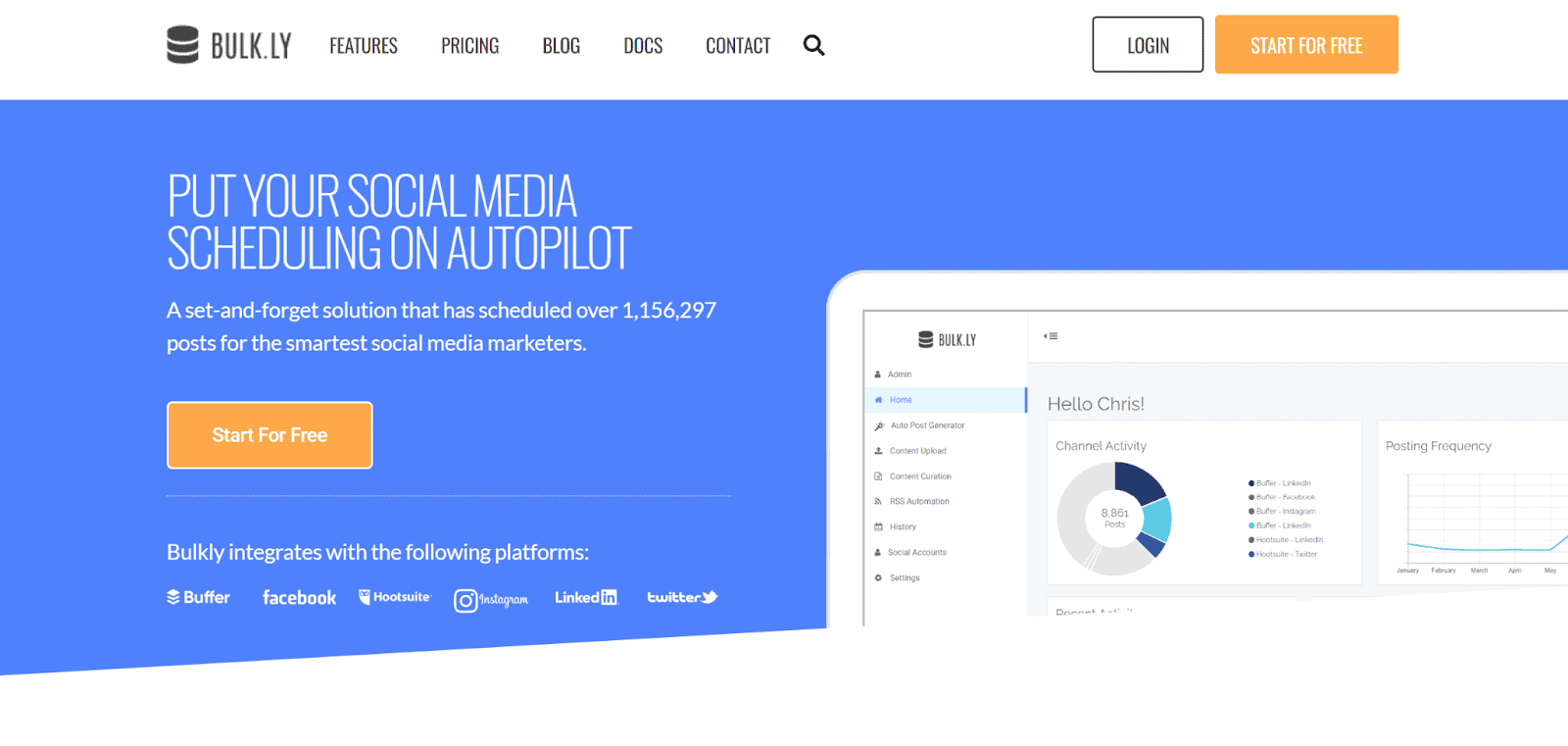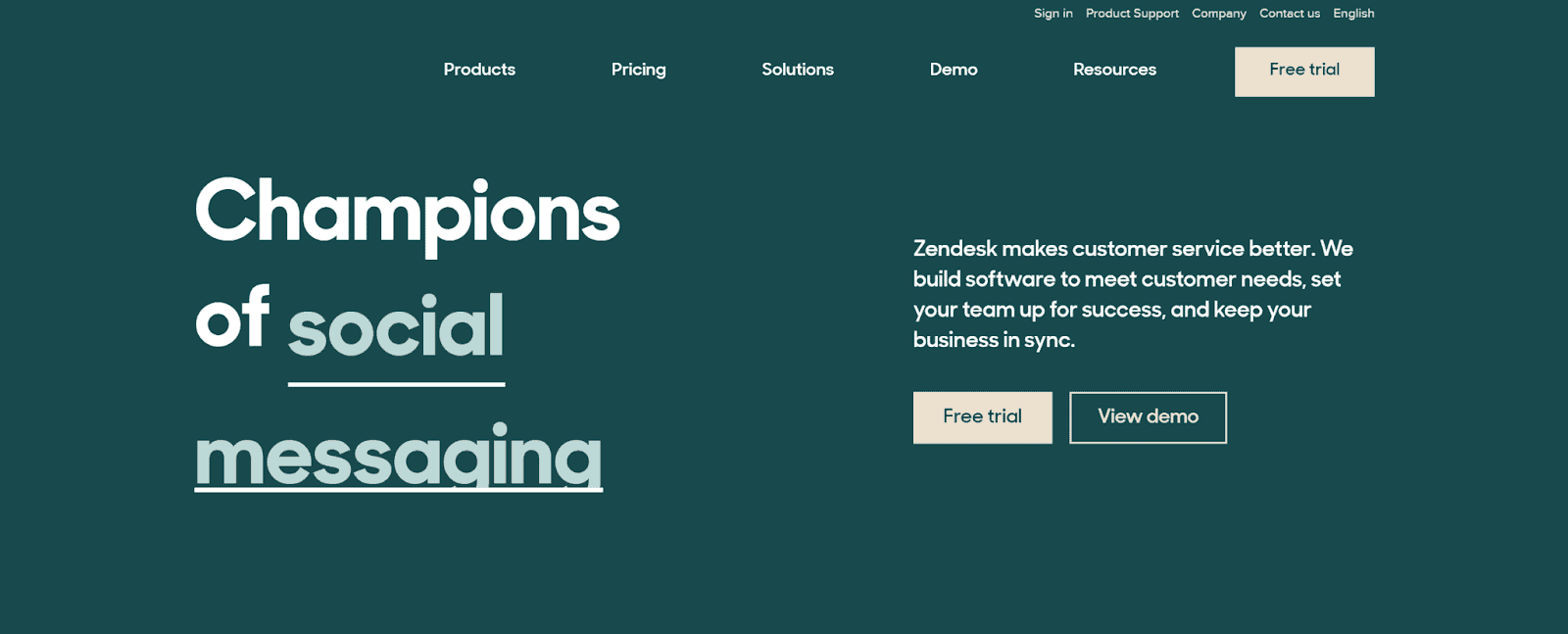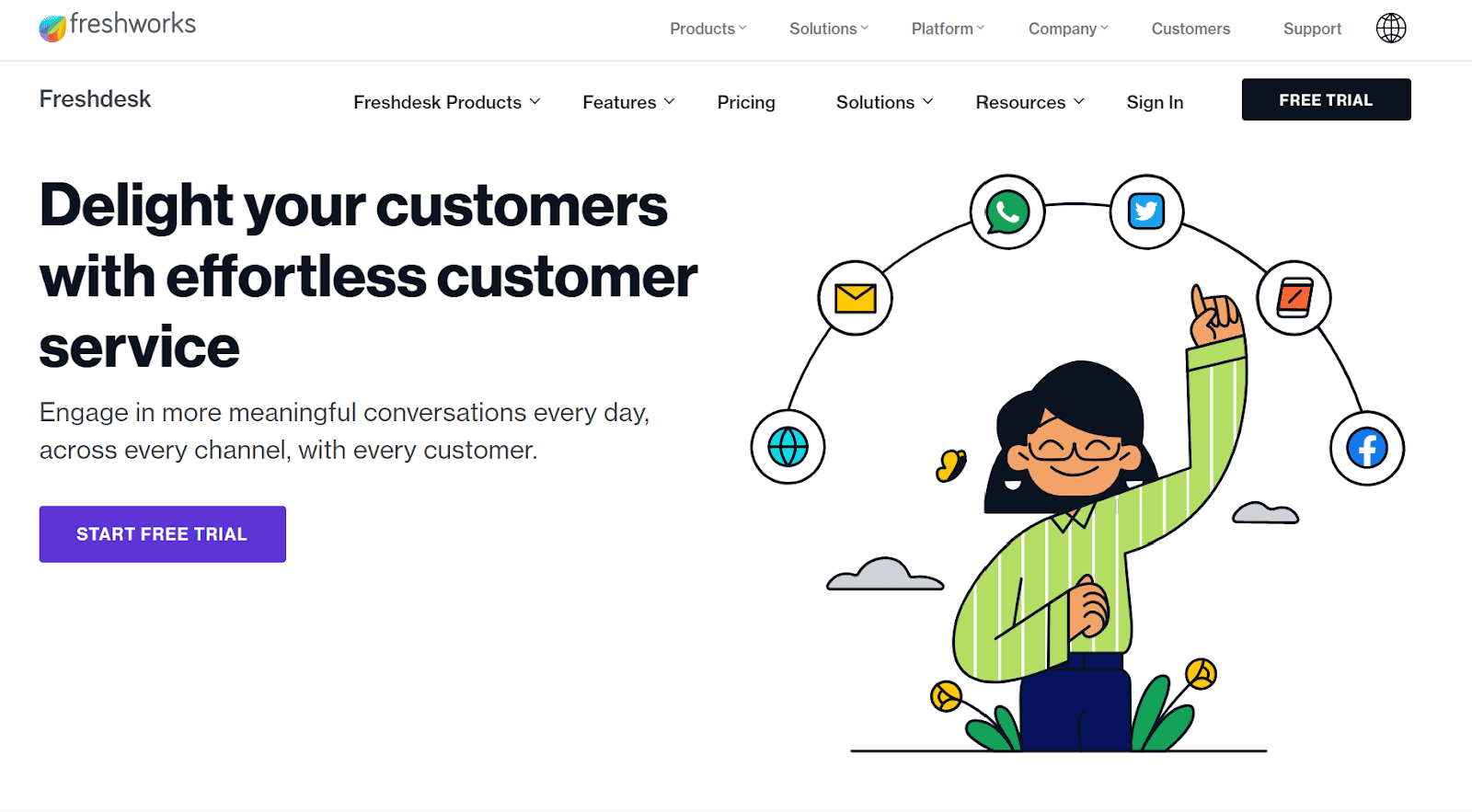The days when the only point of contact with a business was its phone number are long gone. Prominent brands provided an email address as well, but those were frequently regarded as secondary options for consumers. Today, with an increase in online commerce, the need to ensure a successful digital customer experience has never been higher.
Brands go global with perks like free worldwide shipping and consumers getting better internet coverage. Take Amazon, for instance. The company started its operations in the US and has since expanded to all corners of the world. Similarly, its biggest competitor, AliExpress has a strong presence in much of Asia and Europe.
But none of these companies could have risen to their existing heights without a strong focus on providing the best digital customer experience. And social media has played a vital role in helping them achieve maximum efficiency in communications and exposure to a vast customer base.
Today, we’ll be examining how you can implement similar tactics to improve the digital user experience for your business. And once you’ve finished reading this post, you’ll know all the tricks to optimize your interactions for a personalized social media digital customer experience.
What Is Digital Customer Experience (DCX)?

Understanding digital customer experience is very simple. It refers to the total number of online interactions a customer has with your online brand. Customer experience starts with your website (user experience) and extends to social media, online chat, after-sales services, and customer support.
Anywhere digital touchpoints with your brand and the customer are made, customer experience comes into play. And the most crucial element in all of this is the perception the customer takes away after the experience. Was their experience with your brand easy and painless, or cumbersome and exhausting?
For instance, if you run an eCommerce store selling children’s facemasks, everything from the layout of the website, and the customer’s shopping cart experience, to product returns and replacements come under digital CX.
If the customers have a quick, responsive experience that allows them to switch between several facemask designs with ease, they are more likely to make a purchase. And that’s the power of good digital CX.
Adding social media to the equation makes the entire enterprise of DCX more vibrant. With brands trying hard to cement a strong presence on social media platforms, a focus on seamless experience is at an all-time high.
The Importance Of Great Social Media Customer Experience
Amidst viral social media campaigns and endless chatter, brands are vying for a percentage of the public eye. This prominence doesn’t just extend to companies trying to carve their 5 seconds of fame online or posting the next viral tweet or trend, but to be a constant and dependable point of contact for any customer query or complaint.

Customers hold all the cards and you can thank (or blame) social media for this shift in the power dynamic. And with this evolution, no more “This call will be reordered for quality and training purposes” prompts by call recording software every time your call was connected to an agent.
While some businesses view social media as nothing more than a backlinking tool, this is far from the truth. Successful businesses approach social media platforms as the best place to build solid foundations with their clients throughout their digital customer journey. A decent customer experience now gets validation from customers online.
With an ever-present community to back up any single customer experience, your company is more likely to rake in praises and commendations from all corners of the globe. Businesses should then start to treat this digital technology as a goldmine of opportunities to try and create digital channels for greater customer engagement.
On the contrary, a negative social media customer experience can ultimately hurt your company’s outlook. Not having existing touchpoints where customers can come and get immediate help can affect customer satisfaction negatively.
Here’s a rundown of all the benefits and additional metrics you can see with a great DCX strategy in place:
- Lower costs of service
- Increased brand equity
- Higher customer retention
- Reduced customer churn rates
- More fulfilling customer interactions
- Higher lifetime value of the customers
- Real-time aggregated data for your teams to use
With the world’s information available on the screens of their mobile devices, customers appreciate genuine brands that take their time to build a consistent digital experience, which translates into customer loyalty for the company.
5 Common Mistakes That Can Hamper Social Media Digital Customer Experience
Most businesses struggle with the basics of DCX which can impact their relationship with the customer and inadvertently affect sales. We see the same common mistakes repeated throughout the industry. Here’s your cue to avoid the following at all costs.

I. Neglecting Customers
The biggest mistake a business can make is to neglect its customers. Once you have decided to cater to customers over social media and provide customer service, your primary objective must be to answer every direct customer feedback or support question.
Your business must ensure that all direct queries and complaints are addressed within 15-30 minutes of receiving them. But if you’re working with a smaller team, ensure that responses don’t go past the 24-hour mark. Remember to be polite and apologetic for any inconvenience they may have faced.
II. Deleting And Hiding Comments And Posts
Spam is the only exception here. Or comments that violate community guidelines. But deleting or hiding negative customer reviews and comments will damage the relationship you have with them.
Customers are privy to companies that only sport 5-star reviews and comments on their websites with glowing testimonials. Not everyone is going to have a perfect experience with your brand. Let the comments reflect both sides of the argument. Respond to negative comments and apologize for the poor experience and assure them you’re rectifying it.
III. Being Overly Defensive
Customers, regardless of how annoyed or angry they are, reached out to you for a reason. Always be thankful to them for bringing any issue to notice, acknowledge their concern, and apologize for the inconvenience.
Being defensive, or worse, going on the attack and refuting the customer is only going to make your brand look peevish. Remember, everyone makes mistakes, but it is how you respond to them that matters.
IV. Not Being Specific And Brief
Overwhelming your customers with a boatload of information isn’t the way to go. Lengthy responses and links to complicated troubleshooting pages confuse the customer and you’ll have to come back to simplify the information anyway. If the answer is complicated, suggest that you move the conversation away from social media.
If the answer is complicated, suggest that you move the conversation away from social media. Privately message or email them with the details they need.
V. Replying To Every Customer In Case Of Mass Issues Or Outages
Don’t take your time out to personally respond to each customer when one update could reach them all on a common issue. Follow the protocol. Apologize for the inconvenience and offer help for specific issues.
Responding to each complaint is going to give them the impression that your brand is “chatbot-happy” and doesn’t provide personalization. It can come across as disingenuous too.
5 Proven Methods To Ensure the Best Social Media Digital Customer Experience
With everything you shouldn’t do out of the way, let’s discuss what you should implement in your digital customer experience strategy and practice from the get-go.
Method 1: Establishing Dedicated Handles For Social Media Customer Support

Most companies today have separate social media accounts for marketing and support. It is because social media marketing teams and dedicated customer service and support staff have different priorities and goals. Separate channels help them achieve these goals.
Your customer service teams can better engage with customers and answer technical queries than the social media marketing teams at the company. Not only is this strategy great for customer service efficiency but can help boost team productivity.
For instance, most companies today operate their main Twitter accounts and have separate “support” accounts as well. Some even personalize these accounts in various languages. Be sure to include support handles in your main profile’s bio or pin them to your profile if the social media platform allows for them.
People searching for your company are more likely to find your main brand account than the much less advertised and followed support accounts. Should your main account receive a support request, redirect it to the support page for additional help.
Method 2: Creating Social Media Guidelines
Social customer support is vastly different from social media marketing and has separate goals to achieve too. The former aims to solve any and every question from the customer while the latter aims to build your brand’s reputation and presence online.
One thing the two have in common is establishing guidelines to follow online. Guidelines that are aligned with your brand’s ideas and values are critical for the proper functioning of your social media digital customer experience and can bring more value to digital interaction all around.
Your brand’s social media guidelines should cover the following points:
- Methods for query escalation
- Response times for each channel or page
- Canned answers to frequently asked questions
- The tone of voice used to communicate with customers
- A contact management software for tracking customer interactions
These guidelines are vital for any company or brand that is looking to establish a solid social media customer experience whilst ensuring they remain useful and proactive.
Method 3: Managing Customer Expectations

Not every company is expected to provide the same standard of customer service. It is one of the biggest things brands overlook as they aim to go above and beyond to resolve customer queries and issues.
A self-service retailer or eCommerce store selling Halloween costumes off of a Shopify website isn’t competing with the likes of shopDisney or any other renowned in-store retailer. And the customers know this too. So the best first step in determining what sort of customer experience you should aim to provide is to figure out who your audience is and understand the customer needs.
Factor in who you are competing against and look at the best examples from the list to follow. The general rule here is that customers expect greater customer service experiences as they pay higher for products. The level of your overall customer experience should then reflect the merchandise or services you sell and at what scale.
Not to mention that social media teams are an expensive investment on the company’s part. Not everyone can afford a dedicated social media team to help existing or new customers. It is therefore important to set customer expectations properly and have clarity in what they can help resolve and how long it’ll take. The bottom line is: customers love transparency.
Method 4: Respond To Most (If Not All) Customers
While it is an obvious rule, most companies struggle to follow it. Social media mobile apps are great at notifying you of any mention that occurs on your platforms and teams can be dispatched to respond to questions promptly.
However, most brands struggle to implement this rule as part of their customer experience. And we don’t blame them. Staying on top of all questions and responses online is a difficult task for any brand. This is why separate tools and digital experience platforms can help you spot them easily.
While we understand that having such dedicated tools can rack up expenses, especially after factoring in your WordPress website development cost, having these on hand is crucial for any company since they can help organize all brand mentions into a single feed for you to monitor and respond to easily.
But responding to queries and mentions is one part of the trade. Responding to them on time is the other half. Most customers agree that a brand responding within the first couple of minutes to their questions or complaints is the biggest factor in building customer loyalty.
However, we understand that your teams may not be available 24/7 and aren’t ready to process and respond to requests as they come. This problem may be easily rectified by implementing chatbots into your digital touchpoints or using Bulkly for automating your social media posts and updates.

Chatbots use Machine Learning and Artificial Intelligence to process user requests and provide the best course of action or answer while human agents are busy or away. Bulkly works on a similar model and provides flexibility to automate all updates and social media posts. This enables you to manage your time more effectively and lets you focus on other things to improve the digital customer experience.
Facebook already has automated response templates for customer queries and Instagram isn’t far behind in this endeavor. If your brand uses a WhatsApp account, you can personalize responses for direct messages there too.
You may even choose to create your bot for different channels. However, customers do get irritated if their complaints are always answered by chatbots so be sure to only use them as the first line of defense for the most commonly asked questions online.
Method 5: Take Public Conversations Private
Common customer complaints and questions on social media are usually related to specific issues about their specific use case or account. For instance, a customer may reach out to their network provider, bank, or airline for a question on their account or booking.
These cases are personalized and need to be handled privately as they may contain the customer’s confidential details such as name, address, and account/flight number. The fix for such situations is very easy.
Reply to the initial message with a positive acknowledgment and then suggest taking the conversation to their private direct messages or inbox for safekeeping interests. This technique can be implemented on Facebook, Twitter, LinkedIn, and Instagram with ease.
Request them to send a DM (direct message) to your support account where the agent can further address the query without disclosing the personal information of the client. Facebook is great at implementing this feature as comments can be automatically marked with “Page responded privately” if you choose to send them a direct message instead of replying in the comments.
On Twitter and elsewhere where such features aren’t built-in on the platform, reply to the initial message or tweet with “Please check your DMs” so other people can see that you responded to the query privately. Not doing so can give off the impression that you weren’t available for the resolution or simply ignored the customer.
3 Best Tools To Improve DCX
Let’s take a look at some of the most effective tools that can help you in your digital transformation journey for a personalized experience.
1. Bulkly

Bulkly is primarily a social media post scheduler that works on a multitude of social media platforms. The software can be deployed in a personal or business capacity and allows users to save time by scheduling their posts and replies in advance.
The software automates updating of your statuses on ongoing or upcoming updates. Flexible account management also allows for the creation of groups of updates for multiple brands. It offers integration options with various social media platforms like Facebook, Hootsuite, and Instagram, to name a few.
2. Zendesk

Zendesk is a powerful CRM and lead-capturing tool for customer service and customer engagement. It is scalable and can be deployed by companies of all sizes, and features a whole host of options that further extend its capabilities.
Zendesk allows the customization of personalized messages and a robust ticketing system that helps prioritize customer concerns based on their urgency. It is a secure platform that leverages customer data, allows brands to be more customer-centric, and helps convert interactions into relationships.
3. FreshDesk

FreshDesk operates as a customer service platform focused on enhancing the omnichannel experience and has similar ticket management systems to Zendesk and other software in this space. The differentiator that separates FreshDesk from the rest is its ability to manage end-to-end field service operations and AI-enabled tools for process automation.
It has a chatbot that can be personalized and has shared ownership of tickets, team huddles, and linked tickets for better digital customer experience management. FreshDesk functions as a single platform for all your customer service and experience requirements.
Digital User Experience and it’s need
DCX is a vital part of today’s commerce and ensuring a smooth customer journey is essential for the longevity of any business. With our guide today, you’re on your way to implementing a great digital customer experience strategy for your brand.
If you require a tool that puts your social media posts on autopilot, look no further than Bulkly. Built for marketers and support staff, this all-in-one platform is perfect to enhance your DCX and online post-scheduling. You can visit our website to see the full list of features or contact us for additional details.


